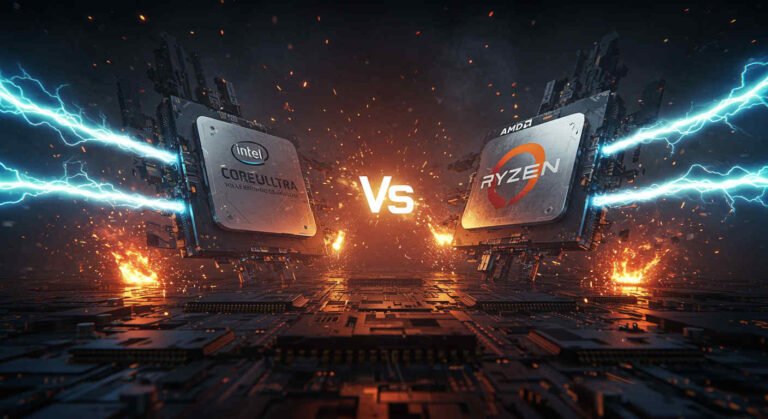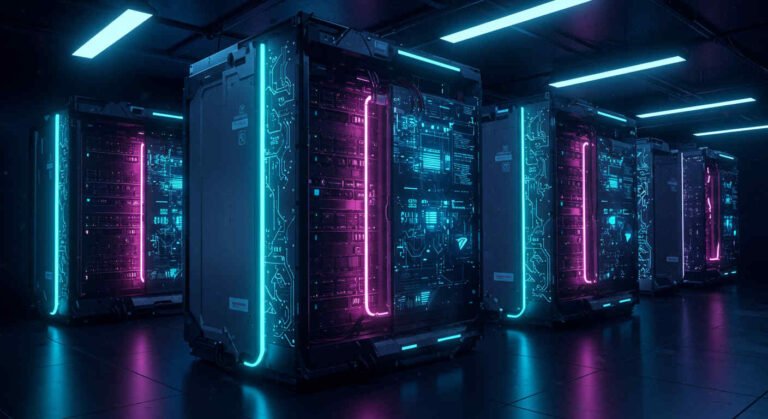AMD Ryzen 8000 (Zen 5): What’s It Packing?

Table of Contents
Alright, y’all, it’s time to get hyped—the CPU world’s about to blow up like a Fourth of July fireworks finale! AMD’s Ryzen 8000, rocking the Zen 5 vibe, is squaring off against Intel’s 14th Gen posse—Raptor Lake Refresh, Arrow Lake, and Lunar Lake—in a slugfest set to hit late 2024 and roll into 2025.
This ain’t just some geeky spec-off; it’s a full-blown cage match for the performance crown, and it’s gonna rattle everything from your gaming rig to your video-editing beast. AMD’s swinging with Zen 5, promising a next-level punch that’s got tech heads buzzing like bees on a honeysuckle vine, while Intel’s countering with a triple-threat combo:
Raptor Lake’s tweaks and the big-boy Arrow Lake and Lunar Lake plays that could shake the ground like a summer thunderstorm. Forget bragging rights on some nerd chart—this is real stakes, fam. Your CPU pick’s gonna juice your frame rates, turbocharge your work grind, or maybe leave your bank account crying for mercy louder than a kid who dropped his ice cream cone on a hot sidewalk.
Whether you’re slapping together a monster PC from the ground up—dreaming of that custom water-cooling loop and RGB glow—or upgrading your dusty old box that’s been chugging along since the Obama years, this choice is straight-up clutch.
Maybe you’re just geeking out on tech’s cutting edge, scrolling forums at 2 a.m., drooling over leaked specs like a dog eyeing a ribeye. Either way, this showdown’s got your name on it. The stakes ain’t small—pick the right chip, and you’re flying high with buttery frames in Call of Duty or slicing through 8K video renders like a hot knife through butter.
Pick wrong, and you’re stuck with a sluggish rig that overheats faster than a black car in July, leaving you with a lighter wallet and a sour taste.
We’re diving deep—way past the marketing fluff those suits love to sling—to give you the unfiltered lowdown, straight from the gut. No corporate buzzwords or glossy ads here—just the raw, real scoop on what’s coming.
We’ll stack up the architecture vibes, digging into the nitty-gritty of Zen 5’s core tweaks and Intel’s tile-based gambit, breaking down how these silicon slabs are built to slug it out. We’ll throw down predictions on how these bad boys will flex—think frame rates that’ll make your monitor sing, multi-core grunt that’ll chew through workloads like a woodchipper, and power sips that won’t jack up your electric bill sky-high.
Cash is king, so we’ll break down what you’ll cough up—will AMD keep its budget bro crown, or will Intel’s premium play steal the show? We’re scoping out the platform perks too—PCIe lanes for your GPU and SSDs, DDR5 speeds that’ll make your RAM dance, and chipset extras that could tip the scales in a photo finish.
But it ain’t just about the numbers—we’re pinning down which one’s your MVP based on your daily hustle. You a gamer chasing 240 FPS in Valorant?
A video editor wrestling 4K timelines in Premiere Pro? Or just a regular Joe streaming Stranger Things while doom-scrolling Twitter? We’ve got your back with picks for every vibe.
Plus, we’ll chew on the juicy extras that spice up the fight: brand loyalty wars—Team Red vs. Team Blue, a rivalry hotter than a tailgate grill—ecosystem quirks that could lock you in or set you free, and overclocking flex that’ll make your rig purr like a kitten or roar like a V8 on a backroad.
This ain’t some dry tech manual—it’s a front-row seat to the CPU rumble of the year, dripping with stakes, swagger, and a whole lotta horsepower.
Picture this: late 2024, the leaves are falling, and the tech world’s buzzing like a hornet’s nest. AMD’s dropping Zen 5 bombs at a keynote, flaunting die shots and benchmarks that make the crowd hoot like they’re at a rodeo. Intel’s firing back, unveiling Arrow Lake’s tile trickery at CES, with execs in sharp suits promising it’s the future of computing.
Forums are lighting up—Reddit threads popping off, Discord servers humming with leaks, and YouTubers like Linus Tech Tips hyping pre-release samples. It’s a circus, fam, and we’re here to cut through the noise. Will Zen 5’s IPC boost and 3D V-Cache make it the gaming GOAT? Can Intel’s hybrid hustle and single-core swagger hold the line? Or will power efficiency and price tags flip the script?
We’re peeling back the layers—think of it like cracking open a cold one and spilling the tea on what’s really cooking under those heatspreaders.
This CPU party’s about to pop off, and it’s bigger than just picking a chip—it’s about where tech’s headed. AMD’s been the underdog turned champ, clawing back market share with Zen’s relentless grind. Intel’s the old-school titan, scrambling to reinvent itself with tile tech and hybrid smarts.
Both are gunning for your rig, your loyalty, and your cash, and they’re bringing everything they’ve got to the table. So grab your popcorn, crank the AC, and let’s roll—this ain’t just a showdown, it’s a tech-fueled slugfest that’ll echo from your basement battlestation to the boardrooms of Silicon Valley. Who’s ready to rumble?
AMD Ryzen 8000 (Zen 5): What’s It Packing?
AMD’s been on a tear with Zen, flipping the script and torching Intel’s once-comfy lead. Zen 5’s the next big haymaker, and the grapevine’s buzzing with whispers of some serious firepower. Here’s what Team Red’s likely cooking up:
- Architectural Glow-Up: Picture this—cores so slick they’re practically gleaming, with an IPC (instructions per clock) boost that’s all about more bang per tick. That’s the magic sauce: how much work a core squeezes out in one cycle. Word is, Zen 5’s tweaking branch prediction—like a psychic guessing your next move—beefing up cache layers for quicker data grabs, and souping up execution units to churn through tasks like a hot rod on nitrous. Compared to Zen 4 (Ryzen 7000), which already punched up IPC by 13% over Zen 3, Zen 5 might aim for a 15-20% jump—some leakers even whisper 25% if AMD’s feeling frisky.
- Process Node Leap: Rumor mill’s spinning—AMD’s likely hopping to TSMC’s 4nm or even 3nm process. Smaller nodes mean more transistors crammed in, sipping less power while maybe cranking clocks higher. Zen 4’s 5nm was a beast; dropping to 3nm could shrink power draw by 30% or goose performance by 15%, per TSMC’s playbook. That’s less heat, more headroom—perfect for pushing the envelope.
- Core Count Bump (Maybe): The core count arms race chilled a bit, but AMD might still flex here, especially for high-end desktop (HEDT) or server chips. Zen 4 topped out at 16 cores for Ryzen 9 7950X—imagine Zen 5 nudging that to 20 or 24 for the big dogs. More cores, more threads, more multi-tasking shred. Even mid-tier chips might see a bump, like a Ryzen 7 jumping from 8 to 10 cores—pure speculation, but it’d keep the pressure on Intel.
- Graphics That Slap: AMD’s integrated GPUs have been schooling Intel’s for years. Zen 5’s expected to roll with RDNA 3 (Ryzen 7040’s vibe) or maybe RDNA 4—think 1080p gaming without a discrete card, no sweat. We’re talking 12-16 compute units, crushing Intel’s Iris Xe for casual titles like Fortnite or Rocket League. Great for budget builds or if your GPU croaks mid-session.
- AI Muscle: AI’s the buzzword, and AMD’s not sleeping on it. Whispers hint at dedicated AI hardware—think neural processing units (NPUs)—baked into Zen 5. That’s a turbo boost for machine learning, real-time rendering, or even smart features like auto-overclocking. Intel’s dipping into this with Meteor Lake’s NPU; AMD might counter with 10-15 TOPS (trillions of operations per second) of AI grunt—total guess, but it’d be a slick flex.
Intel 14th Gen (Raptor Lake Refresh, Arrow Lake, Lunar Lake): What’s the Play?
Intel’s been playing catch-up, and 14th Gen’s their three-pronged counterattack—each with its own flavor:
- Raptor Lake Refresh (Desktop): This is 13th Gen on a protein shake—higher clocks (think 6GHz peaks on the i9-14900K), a few tweaks, and solid gains over Alder Lake. It’s not a ground-up redo, more like a “let’s squeeze this lemon harder” move. Same hybrid P-core/E-core setup, same LGA 1700 socket—familiar turf, just punched up.
- Arrow Lake (Desktop & Mobile?): Here’s the wild card—a tile-based shake-up splitting CPU, GPU, and I/O into separate chunks. Think Lego blocks: mix and match process nodes (maybe Intel 20A—2nm vibes—or 18A) for peak efficiency and power. New cores could juice IPC by 10-15%, and rumors peg a new socket (LGA 1851) for late ’24 or early ’25. This ain’t just a refresh—it’s Intel swinging for the fences.
- Lunar Lake (Mostly Mobile): Built for laptops, Lunar Lake’s all about sipping power—think thin-and-light champs like MacBook Air killers. Tile tech keeps it lean, with hybrid P-cores and E-cores tuned for battery life over brute force. Might sneak into low-power desktops, but it’s a mobile-first play.
- Hybrid Hustle: Intel’s sticking with its P-core/E-core tag team—Performance cores for the heavy lifting (gaming, rendering), Efficient cores for background hum (web tabs, Spotify). Raptor Lake Refresh tweaks this; Arrow Lake might refine it further with beefier E-cores for multi-threaded grunt.
- Single-Core Swagger: Intel’s been the single-threaded king forever—crucial for games like CS:GO or Cyberpunk 2077. They’re not letting AMD steal that crown, banking on high clocks and tight latency to keep the edge.
The Showdown: Where They’ll Duke It Out
This ain’t a one-punch KO—it’s a multi-round slugfest. Here’s where the gloves come off:
- Gaming Glory: Single-core speed’s the champ here—think 5-10% frame boosts in Call of Duty or Baldur’s Gate 3. Cache size (AMD’s 3D V-Cache?) and memory bandwidth (DDR5 at 6000MT/s?) will flex too. High-res gaming (4K) leans multi-core, but 1080p’s all about that single-thread snap.
- Content Creation Crunch: Video editors and 3D artists need thread count, multi-core muscle, and fat memory pipes—think 8K renders in Premiere Pro or Blender scenes that’d choke lesser chips.
- Power Vibes: With electric bills spiking, efficiency’s a sleeper hit. A chip sipping 100W vs. gulping 250W could save your wallet—and keep your room from turning into a sauna.
- Price Tag Showdown: Raw speed’s cool, but bang-for-buck wins hearts. A $400 chip outpacing a $600 rival? That’s the real MVP.
- Platform Perks: PCIe lanes for GPUs and SSDs, DDR5 speeds, iGPU clutch, and chipset extras (USB4 vs. Thunderbolt)—it’s the whole package, fam.
Intel 14th Gen (Raptor Lake Refresh, Arrow Lake, Lunar Lake): What’s the Play?
Part 1: Architectural Lowdown

AMD Ryzen 8000 (Zen 5):
- Core Game: Zen 5 picks up where Zen 4 (Ryzen 7000) left off—think IPC gains of 15-20%, maybe via wider pipelines or smarter prefetching. Cache could balloon—say, 48MB L3 base, 96MB with 3D V-Cache—to feed those hungry cores.
- Cores & Threads: Zen 4 maxed at 16 cores/32 threads—Zen 5 might nudge to 20/40 for the Ryzen 9 8950X, keeping multi-threaded beasts like Cinebench happy. Mid-tier? A Ryzen 7 8700X could rock 10 cores/20 threads.
- Process: TSMC’s 4nm or 3nm—tighter than Zen 4’s 5nm—means more transistors (maybe 20 billion vs. 13 billion) for less juice. Clocks could hit 5.8-6GHz—wild, right?
- Socket Talk: AM5’s the word—AMD promised long life here. No “AM5+” nonsense likely, but DDR5 (up to 6400MT/s?) and PCIe 5.0 (16 lanes GPU, 4 lanes NVMe) are locked and loaded.
Intel 14th Gen:
- Raptor Lake Refresh: Same LGA 1700 as 12th/13th Gen—up to 8 P-cores/16 E-cores (24 threads total) on the i9-14900K, clocks kissing 6GHz. Hybrid’s refined, not reinvented.
- Arrow Lake: Tiles split the game—CPU on Intel 20A (2nm-ish), GPU on TSMC 3nm, I/O on something older. Maybe 6 P-cores/16 E-cores (28 threads?) with an IPC bump. New LGA 1851 socket’s the buzz.
- Lunar Lake: Mobile-first—4 P-cores/8 E-cores, ultra-low 15-30W TDP. Tiles keep it efficient; desktop crossover’s a long shot but not impossible.
Part 2: Performance Face-Off (Our Best Guess)

Here’s our crystal ball take, mixing trends, leaks, and a dash of gut:
- Gaming:
- Ryzen 8000: IPC gains and 3D V-Cache (96MB L3?) could push 10-15% more frames—think 140 FPS in Warzone vs. 120 on Zen 4. Clocks might hit 5.9GHz—nuts.
- Raptor Lake Refresh: i9-14900K’s 6GHz keeps it neck-and-neck—130 FPS in Overwatch 2. Single-core’s still Intel’s jam.
- Arrow Lake: New cores, maybe 5.7GHz—could leap to 150 FPS if tiles play nice. Benchmarks will tell.
- Productivity:
- Ryzen 8000: 20 cores could shred Cinebench R23—say, 40,000 points vs. 7950X’s 38,000. IPC’s the X-factor.
- Raptor Lake Refresh: 24 threads hit 36,000—strong, but power-hungry.
- Arrow Lake: Tiles might scale to 38,000—E-core boosts could shine.
- Content Creation:
- Ryzen 8000: Multi-core and DDR5 bandwidth could cut Premiere Pro exports by 20%—think 10-minute 8K renders vs. 12.
- Intel 14th Gen: Quick Sync Video keeps Raptor Lake snappy—11 minutes. Arrow Lake’s iGPU might edge closer.
- Power Draw:
- Ryzen 8000: Zen 4’s 170W TDP could drop to 150W—3nm’s a beast.
- Raptor Lake Refresh: 253W on i9-14900K—oof, bring a fan.
- Arrow Lake: Tiles might trim to 200W—Intel’s catching up.
Part 3: Cash and Value Vibes

Ryzen 8000: AMD’s been the budget bro—Ryzen 7 7700X launched at $399. Zen 5 might creep to $450-$500, with X3D variants (8700X3D?) hitting $550. Worth it if performance slaps.Raptor Lake Refresh: i7-14700K’s $409—deals dip it to $380. i9-14900K’s $589—pricey juice.Arrow Lake: Tiles could push i7s to $500, i9s to $650—value hinges on benches. A steal at $450, a rip-off at $700. It’s your wallet’s call—stellar gains might greenlight a splurge, or tight pricing could snag the W.
Part 4: Platform Goodies

- AMD AM5 (Ryzen 8000):
- DDR5 up to 6400MT/s—blazing. PCIe 5.0 (16 GPU, 4 NVMe)—future-proof. USB4’s 40Gbps—zippy. Chipsets like X870E might pack Wi-Fi 7, extra lanes.
- Intel LGA 1700 (Raptor Lake Refresh):
- DDR5 (5600MT/s) or DDR4 (3200MT/s)—flexible but dated. PCIe 5.0 (16 GPU, 4 NVMe)—solid. Z790’s got USB 3.2 Gen 2×2 (20Gbps).
- Intel Next-Gen (Arrow Lake?):
- DDR5 only—6000MT/s+. PCIe 5.0 (6.0 whispers)—next-level. Thunderbolt 5 (80Gbps)—data lightning.
Part 5: Your CPU Pick (What’s Your Deal?)

- Gaming:
- High-End: Ryzen 9 8950X3D ($650?) or Arrow Lake i9-14900KS ($700?)—frame lords. Check Tom’s Hardware post-launch.
- Mid-Tier: Ryzen 7 8700X ($450) or Intel i7-14700K ($409)—1440p royalty.
- Budget: Ryzen 5 8600G ($250) or Intel i5-14400 ($220)—1080p MVPs.
- Content Creation:
- High-End: Ryzen 9 8950X ($600) or Intel i9-14900K ($589)—8K beasts.
- Mid-Tier: Ryzen 7 8700X or Intel i7-14700K—sweet spot for After Effects.
- Everyday Hustle:
- Ryzen 5 8500G ($180) or Intel i3-14100 ($140)—Netflix and chill champs.
Part 6: The X-Factors—Loyalty, Ecosystem, Overclocking

- Brand Love: Team Red’s your vibe if Ryzen’s been clutch—Intel’s your jam if Core’s your OG. Don’t let nostalgia blind you—data’s king.
- Ecosystem: AMD’s AM5 might stick ‘til 2027—upgrade city. Intel’s LGA 1700’s on its last legs; Arrow Lake’s LGA 1851’s a fresh start with flashy perks (Thunderbolt 5, anyone?).
- Overclocking: AMD’s X chips (non-X3D) hit 5.9GHz with a beefy AIO—Intel’s K series nudge 6.2GHz. Motherboard and cooling’s the real bottleneck—$200 boards and 360mm rads unlock the beast.
Part 7: Wrap-Up—The Fight Ain’t Over

AMD vs. Intel’s a damn gift—keeps ‘em scrapping, keeps us winning with dope chips and (sometimes) sane prices. Ryzen 8000 and Intel’s 14th Gen are about to throw down like it’s the Super Bowl of silicon. No universal champ—it’s your gig, your bucks, your call. Hold off for real reviews (* AnandTech*, Gamers Nexus—you know the drill), balance your build (don’t pair an i9 with a GTX 1650, fam), and don’t blow your stack on hype. Zen 5’s IPC dreams, Intel’s tile gambit, and AI spice are lighting the fuse—this CPU rumble’s just getting started. Stay locked in—this party’s gonna rage!
See this good video in YouTube: https://www.youtube.com/watch?v=43VUQoGbk4E
See another good article in our blog: https://techforgewave.com/building-a-gaming-pc-in-2025-ultimate-guide/










